Caterpillars often go unnoticed. While we see the beautiful butterflies and moths fluttering about, we usually ignore the larval stage of their development. But if you observe them closely, you might discover just how unique and interesting caterpillars are! In the beautiful state of Maryland, you’ll find a variety of caterpillars. Each caterpillar, with its distinct appearance, is on a journey to become a graceful butterfly or a mysterious moth. While some caterpillars may look usual, others have incredibly unique looks that you won’t find anywhere else in nature!
However, it’s worth noting that among the many caterpillars you might encounter, a handful have developed defensive toxins to deter predators. As we dive into the world of Maryland’s caterpillars, we’ll help you identify 18 caterpillars found in Maryland, seven of which are poisonous or venomous and are best left untouched.
1. Woolly Bear Caterpillar (Pyrrharctia isabella)
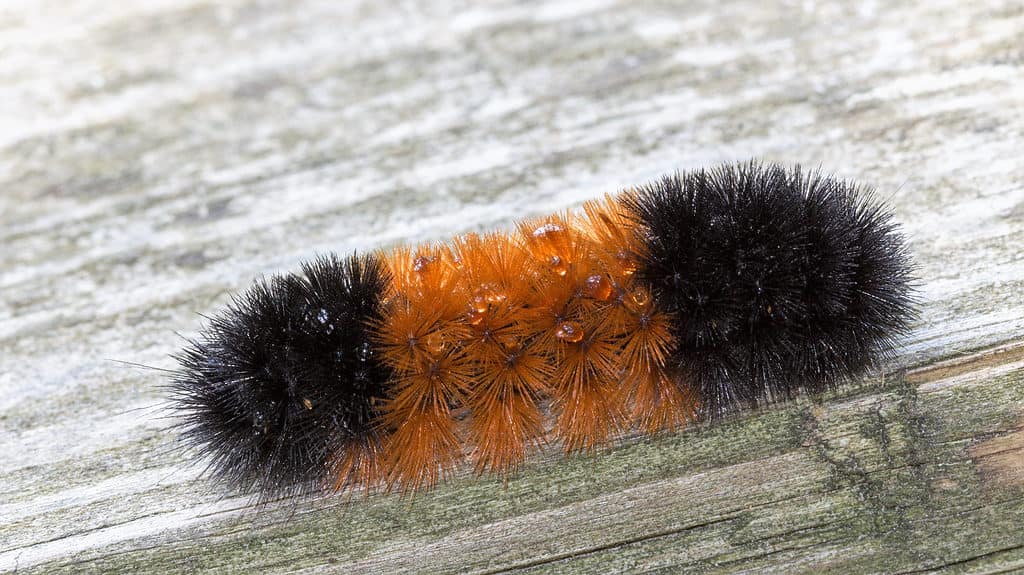
Woolly bear caterpillars are furry in appearance.
©Kimberly Boyles/Shutterstock.com
Frequently spotted in Maryland, woolly bear caterpillars transform into moths as they mature. These caterpillars are distinct with their soft, bristle-coated bodies. They feed on various plants, including grasses and herbs. If you come too close, they might curl up as a protective measure.
These caterpillars thrive in diverse environments, from open meadows and grasslands to vast prairies.
While some hairy caterpillars carry harmful toxins in their bristles, the brown and black woolly bears are surprisingly safe to touch, posing no threat to humans.
2. Definite Tussock Moth Caterpillar (Orgyia definita)

Boasting yellow hairs, the definite tussock moth caterpillar eats a variety of plants.
©Meenu Varghese/Shutterstock.com
The definite tussock moth caterpillar is easily identified by its vibrant yellow hairs. Its head can vary in color from yellow to brown, and it features four distinctive hair tufts that resemble small humps near its head.
These caterpillars are leaf-eaters, consuming foliage from a variety of trees and plants. They’re commonly spotted on both leaf-shedding and evergreen trees, as well as on shrubs and other greenery.
Even though their appearance might suggest otherwise, these caterpillars are harmless and don’t carry any toxins.
3. Eastern Tent Caterpillar (Malacosoma americanum)
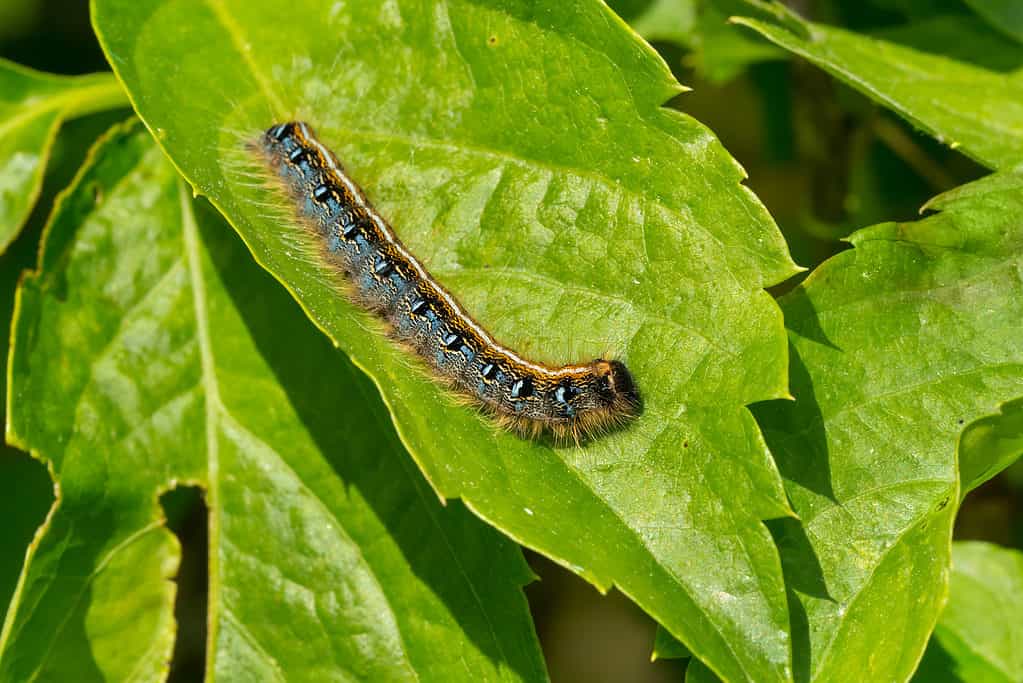
Around 2 inches long, the eastern tent caterpillar eats cherries and crab apples.
©Paul Reeves Photography/Shutterstock.com
The eastern tent caterpillar can be identified by its approximately 2-inch length, dark color complemented by a distinct white stripe running down its back, and pale blue, oval-shaped markings on its sides. They predominantly feed on ornamental cherries, wild cherries, and crab apples.
In the winter, these insects remain in their egg stage. The eggs are placed in circular clusters, wrapping around the slender branches of their favored plants.
Despite their appearance, eastern tent caterpillars pose no threat to people or pets.
4. Eastern Tiger Swallowtail Caterpillar (Papilio glaucus)
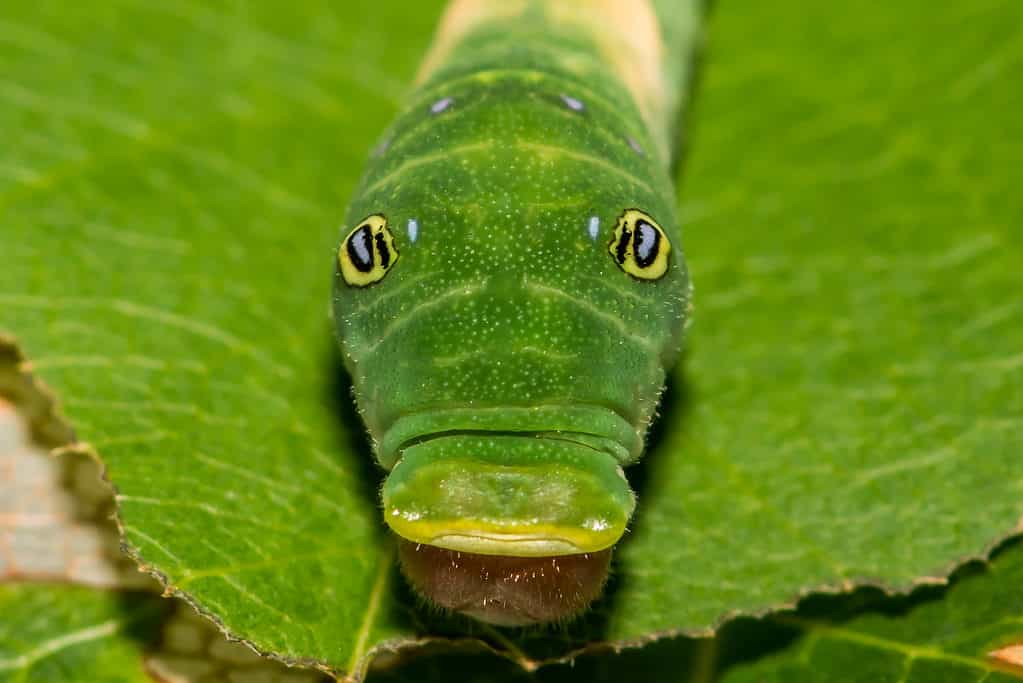
These caterpillars have black, yellow, and blue markings that look like eyes.
©Jay Ondreicka/Shutterstock.com
Eastern tiger swallowtail caterpillars are truly fascinating creatures. In their early stages, they sport brown and white patterns, mimicking bird droppings — a clever camouflage strategy. As they grow, they undergo a transformation, adopting a vibrant green hue with striking black, yellow, and blue markings that resemble eyes located just above their actual eyes.
These caterpillars usually find their homes in trees like the tulip poplar, sweet bay, and wild cherry. They feed on the leaves of these and other woody plants.
Rest assured, these intriguing caterpillars are harmless to humans.
5. Gold Moth Caterpillar (Basilodes pepita)

These caterpillars have a slight sting.
©Wilfreda Wiseman/Shutterstock.com
The gold moth caterpillar measures around 1.57 inches and typically sports an orange hue with encircling black bands. Additionally, a series of white spots can be observed on either side of its body. With a light orange head and a soft yellow belly, its appearance is quite striking.
The gold moth remains a bit of an enigma due to its rarity. Their preferred meals include leaves from crownbeard and wingstem plants, with the latter often growing alongside riverbanks and within swampy regions.
The gold moth caterpillar might deliver a sting, but it doesn’t bite. It’s worth noting that while their stings aren’t particularly venomous, ingesting the moth can pose health risks.
6. Hickory Horned Devil Caterpillar (Citheronia regalis)

Although they may look dangerous, hickory horned devil caterpillars are actually safe to touch.
©Matt Jeppson/Shutterstock.com
The hickory horned devil is a colorful caterpillar from the regal or royal walnut moth. When they’re young, these caterpillars can be brown or orange in color. As they grow up, they turn mostly green and have black, cream, and sometimes even light blue patterning on their sides. Some of them can become a bright shade of turquoise green when they’re about to transform.
They eat leaves from trees like hickory, walnut, ash, and a few others. Both the grown-up moth and its caterpillar form are safe and won’t harm you.
7. Imperial Moth Caterpillar (Eacles imperialis)

Growing to 5 inches long, the imperial moth caterpillar can be brown or green.
©Matt Jeppson/Shutterstock.com
The imperial moth caterpillar is quite a sight to see! As they grow, they become big, plump worms that can stretch from three to five inches. Some are brown with noticeable orange dots, while the green ones display yellow markings on their upper body and a row of yellow dots on their sides.
These caterpillars love hanging out in pine and spruce woods, but you can also find them in forests filled with trees like maple and oak. Their menu includes leaves from many trees, but they have a soft spot for pines, oaks, and a few others.
Unfortunately, imperial moth caterpillars have stinging hairs. If you touch it, your skin might burn or itch. In the worst scenarios, it can even cause serious eye problems or be deadly if swallowed!
8. Large Tolype Moth Caterpillar (Tolype velleda)
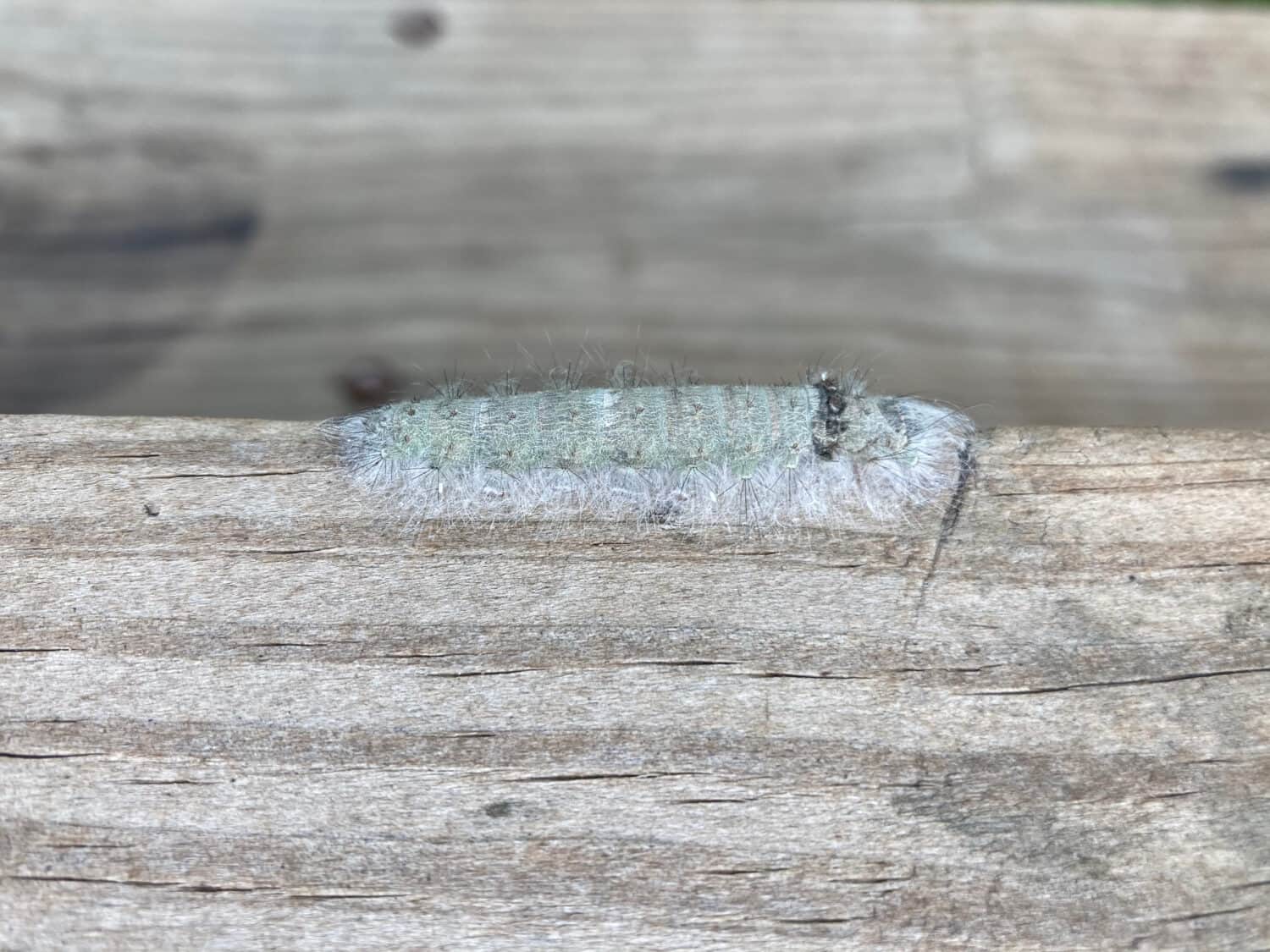
Gray and hairy, the large tolype moth caterpillar has a flap near its legs.
©B. Kelly Swanson/Shutterstock.com
The large tolype moth caterpillar is a gray, hairy creature. Unique features include brown or reddish-orange bumps on its upper body and a special flap near its legs.
You’ll often spot these caterpillars in wooded areas and city green spaces. They have a preference for feeding on leaves from trees like apples, beech, and elm, among others.
These caterpillars are poisonous! If someone accidentally eats them, they might experience stomach issues like nausea or even more serious health concerns.
9. Monarch Caterpillar (Danaus plexippus)

Interestingly, monarch caterpillars exclusively eat milkweed.
©Cathy Keifer/Shutterstock.com
Monarch caterpillars are adorned with striking yellow, black, and white stripes. They also have tentacle-like features at both ends and grow up to two inches long before transforming into butterflies.
The key to their survival is the milkweed plant. This is the sole source of food for the monarch caterpillars.
Interestingly, these caterpillars carry a potent toxin that acts as a defense mechanism, warding off potential predators.
10. Pipevine Swallowtail Caterpillar (Battus philenor)

A caterpillar you might find in Maryland is the pipevine swallowtail.
©Sundry Photography/Shutterstock.com
Pipevine swallowtail caterpillars boast a unique appearance, with their black bodies highlighted by red spiky outgrowths and spots. Their unmistakable look, coupled with their bright red-orange eggs, serves as a warning to potential threats.
You’ll often spot these caterpillars in warmer environments, like sunny meadows and light-filled forests, eating birthworts and Dutchman’s pipes. If you’re keen on having these butterflies grace your garden, consider planting some birthwort vines, which are usually available at local plant stores.
A word of caution: both the young caterpillar and the butterfly contain toxins that make them harmful.
11. Puss Caterpillar (Megalopyge opercularis)

One of the more interesting caterpillars you might come across in Maryland is the puss caterpillar.
©Chase D’animulls/Shutterstock.com
The puss caterpillar is a hairy little critter that calls the southern U.S. home, spanning areas from Texas to Maryland. Characterized by its fluffy appearance, this caterpillar grows up to an inch long and sports a dense coat of tan to grayish-white fur. The longer hairs on its body thin out towards its tail end.
You might spot these caterpillars in forests, but they’ve also been seen in open fields, backyards, and city parks. Their diet includes leaves, especially those from poplar, sallow, oak, and willow trees.
These caterpillars have venomous spikes. A touch can lead to excruciating pain and, in some cases, leave behind blisters that persist for weeks!
12. Spiny Elm Caterpillar (Nymphalis antiopa)
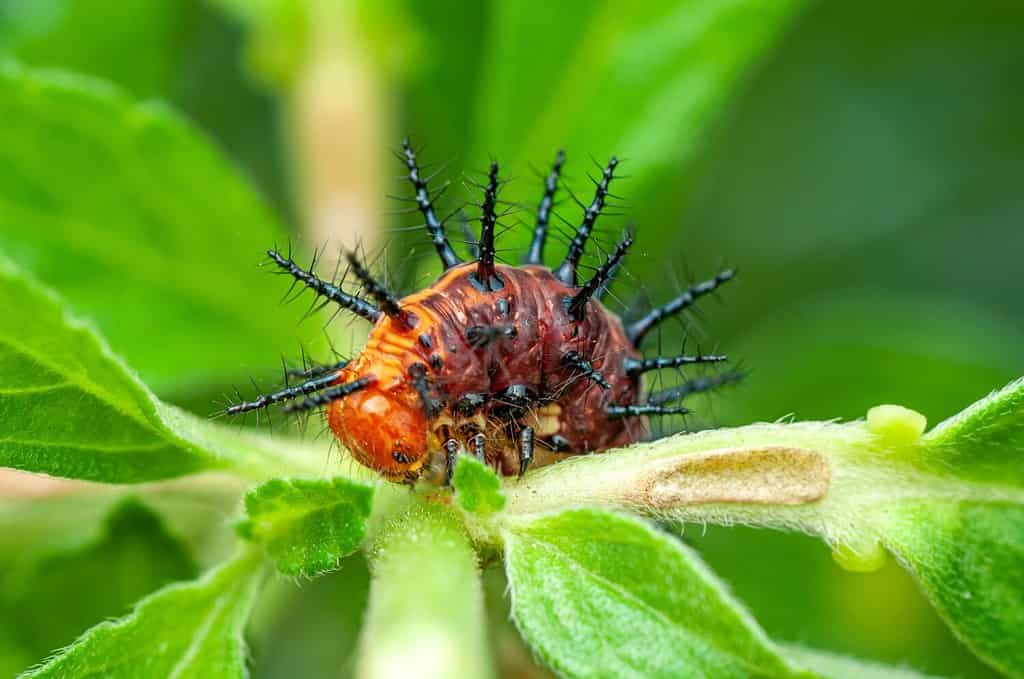
This caterpillar eventually transforms into the mourning cloak butterfly.
©CHONG LIANG YAN/Shutterstock.com
The spiny elm caterpillar measures around 2 inches. This black, prickly caterpillar is dotted with tiny white specks and sports a line of red markings between its spikes.
These caterpillars have a broad palate, feeding on leaves from various trees such as elm, poplar, and willow, among others.
Interestingly, this caterpillar, which later transforms into the mourning cloak butterfly, can sting. It has spines that are believed to contain toxins.
13. Stinging Rose Caterpillar (Parasa indetermina)
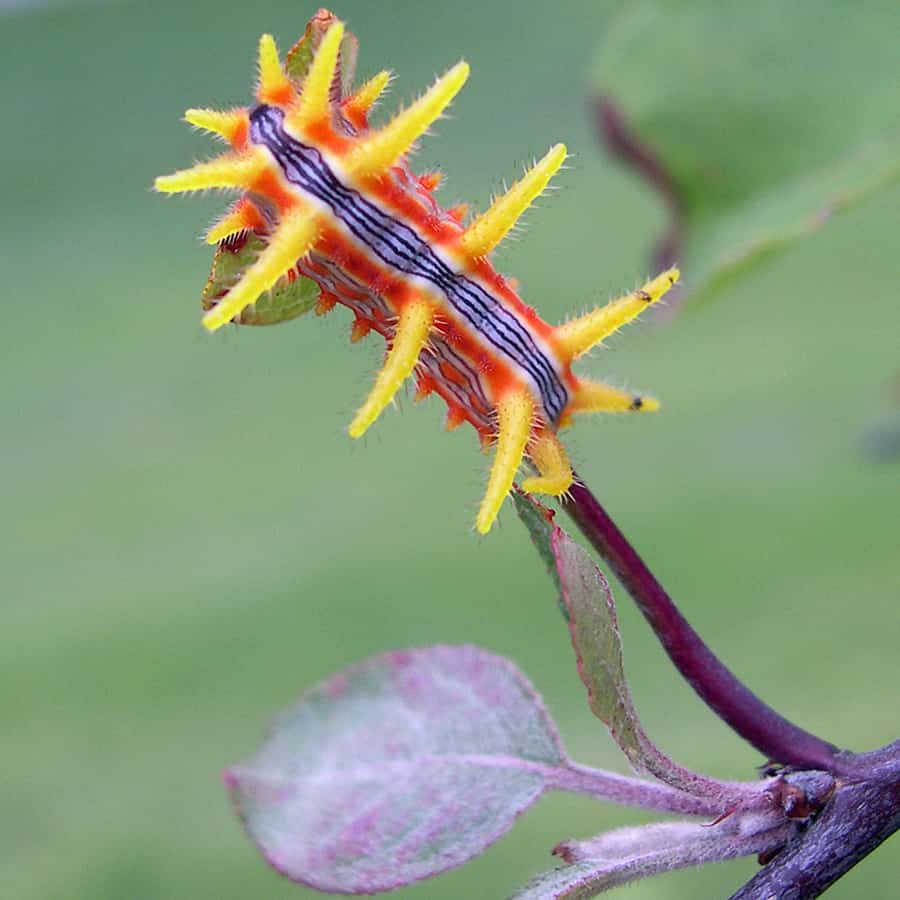
As you might be able to guess from its name, the stinging rose caterpillar in Maryland can sting!
©M. Whitson / CC BY 4.0 – License
Stinging rose caterpillars are vibrant creatures, showcasing hues of red, orange, and yellow. Imagine shades of cherries, oranges, and lemons. These little insects, about the size of your thumb, are adorned with bunches of spiky bristles and dramatically pointed horns.
Their appetite is varied; they enjoy eating leaves from apple, cherry, and maple trees, to name a few. Spotting this species can be a rare treat in Maryland.
Their spiky bristles are filled with an irritating liquid. This liquid can be released when touched, resulting in a quite unpleasant sting.
14. White Furcula Moth Caterpillar (Furcula borealis)
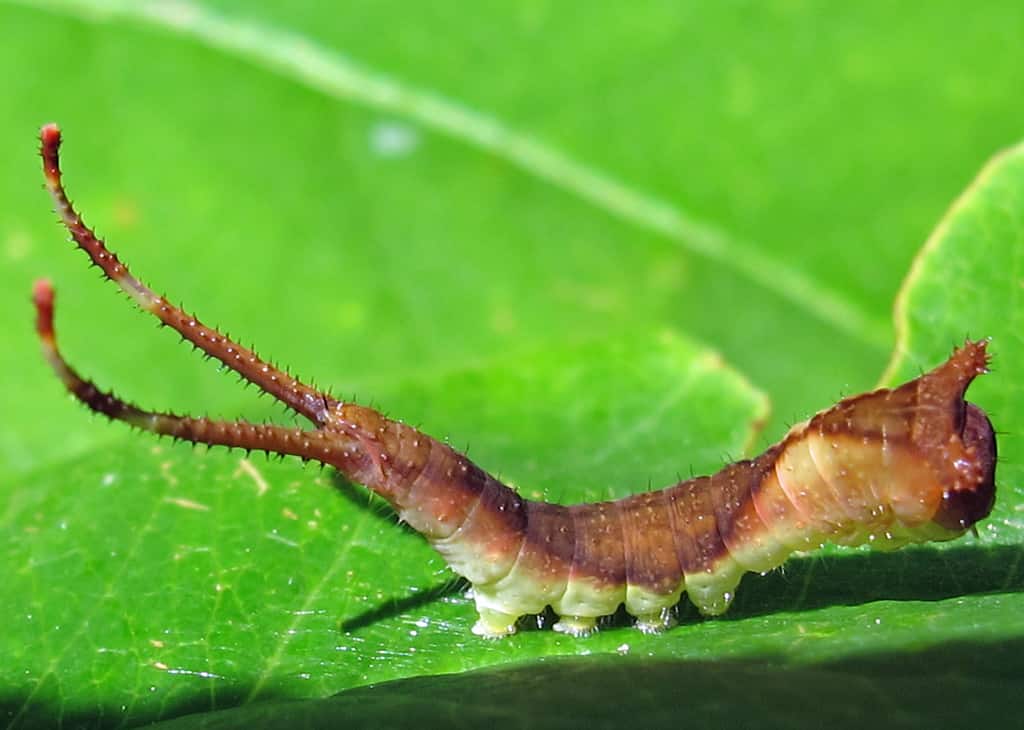
Another unique caterpillar in Maryland is the white furcula moth caterpillar.
©Jacy Lucier / CC BY-SA 4.0 – License
The white furcula moth caterpillar showcases a yellow or green body, accentuated by a dark brown diamond shape in its center. This same brown hue extends to its head and traces down to a slender, forked tail.
They often enjoy munching on leaves from cherry, poplar, and willow trees.
While the white furcula moth caterpillar might catch your eye, there’s no need for alarm. They’re not harmful and won’t cause any health concerns for humans.
15. Monkey Slug Caterpillar (Phobetron hipparchia)
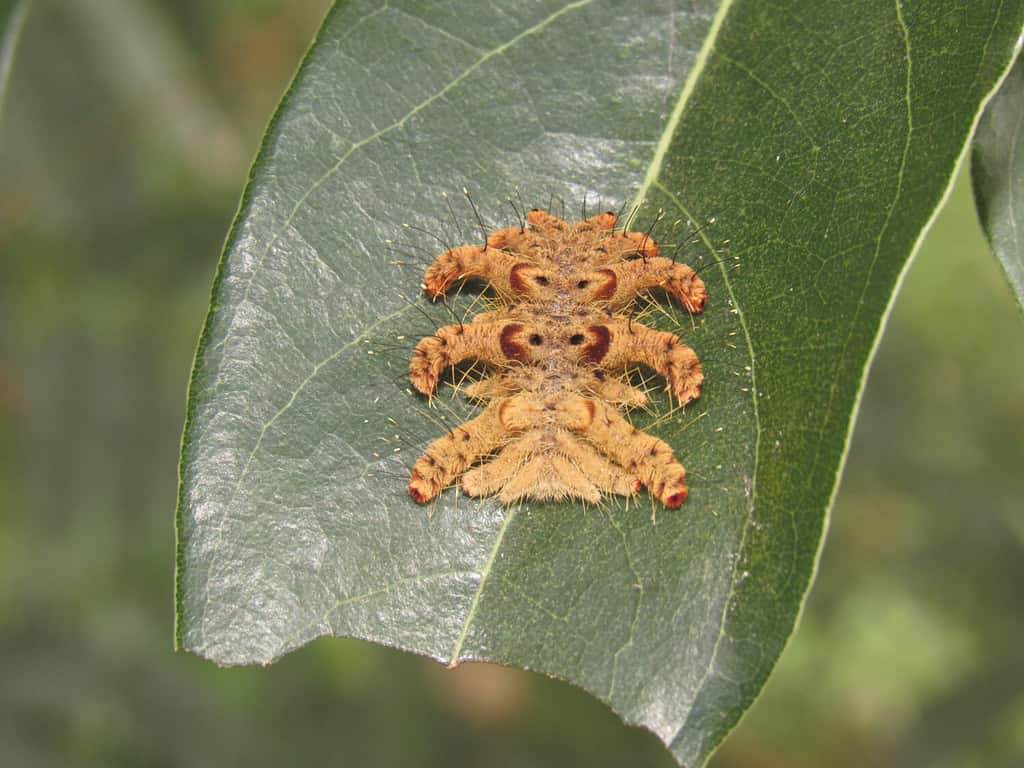
Looking more like a hairy
starfish
than a caterpillar, the monkey slug dwells on the underside of leaves.
©Fabio Ara/Shutterstock.com
The monkey slug caterpillar, which grows into the hag moth, bears a peculiar resemblance to a fuzzy, brown starfish that’s slightly stretched out.
These larvae prefer dwelling on the underside of leaves and enjoy feasting on various deciduous trees and shrubs, including apple, ash, birch, and cherry.
Though it might look like something out of a spooky story, the monkey slug caterpillar is generally harmless.
16. Luna Moth Caterpillar (Actias luna)
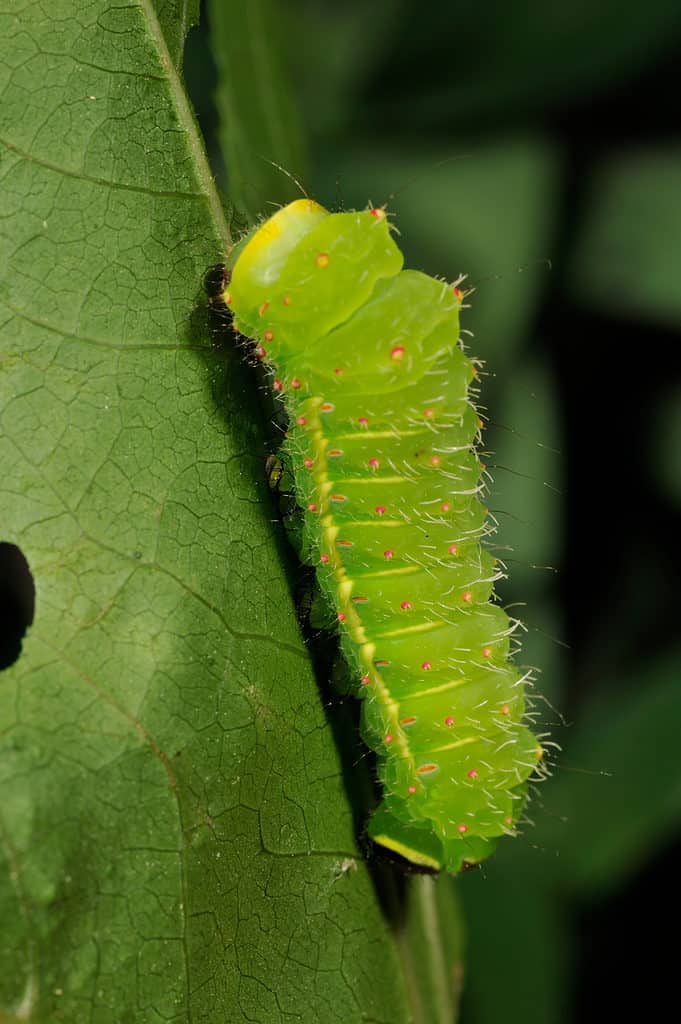
The luna moth caterpillar eats leaves from walnut, hickory, and sweetgum trees.
©Breck P. Kent/Shutterstock.com
Luna moth caterpillars are a soft shade of green, adorned with yellow stripes along their sides and dotted with tiny red markings. The mature luna moth stands out with its robust body and verdant wings, showcasing a distinctly dark edge on the front wings.
Typically seen around deciduous forests, these caterpillars favor dining on leaves from walnut, hickory, persimmon, and sweet gum trees. Unfortunately, factors like habitat loss and bright nighttime lights have seen their numbers dwindle in some places, as these lights can throw off their mating patterns.
Despite their grand appearance, luna moths are quite docile. They have a tiny, pointed spine on their rear end, but it’s not much of a threat.
17. Question Mark Caterpillar (Polygonia interrogationis)
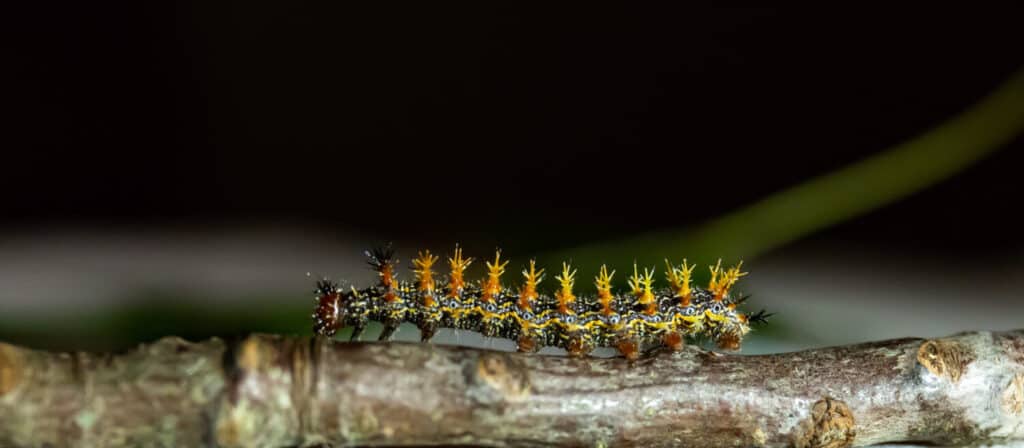
Although they may look dangerous, question mark caterpillars don’t carry any toxins.
©Dank Pics/Shutterstock.com
Question mark butterfly caterpillars might start off as tiny larvae, but they can grow up to 1.5 inches in length. Sporting a reddish-brown head adorned with short spikes, these dark critters showcase streaks and spots across their body. Their segments boast prickly outgrowths, making them look notably spiky.
You’ll often spot them in wooded places or city parks. Basically, anywhere there’s a mix of trees and open ground. Their diet? Leaves from American elm, false nettle, and hackberry, among other plants.
These caterpillars are harmless and don’t carry any toxins despite their deadly look!
18. Skiff Slug Caterpillar (Prolimacodes badia)
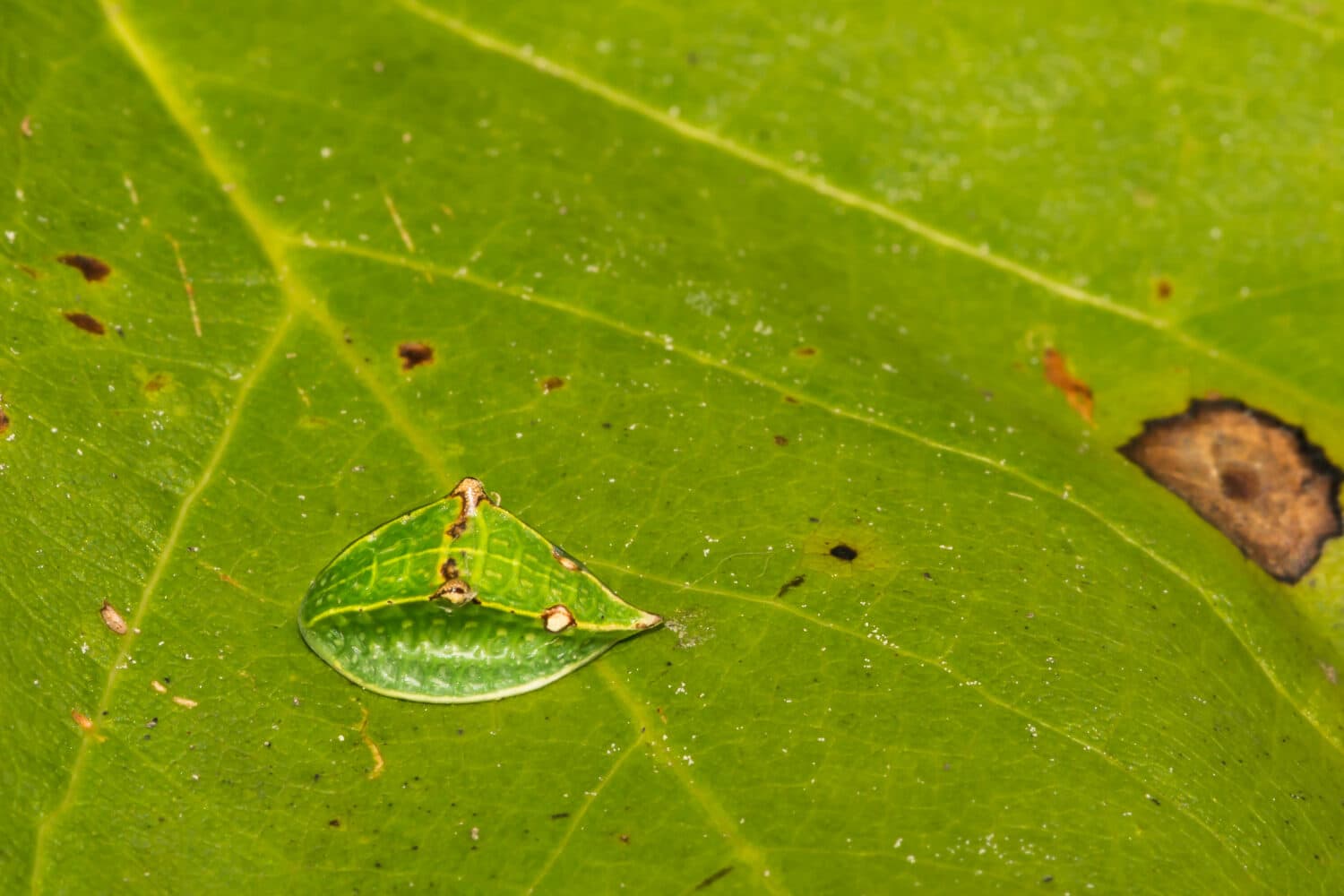
Skiff slug caterpillars can be found on oak, cherry, and maple trees in Maryland.
©Jay Ondreicka/Shutterstock.com
The skiff caterpillar has a unique shape, resembling a tiny, capsized boat with its humped back. Two noticeable ridges run from its front to back, each culminating in a small, sharp peak. With its head tucked in and legs hidden, it genuinely looks like a miniature boat tipped over.
These caterpillars eat leaves from trees such as oak, cherry, and maple, among others.
While some similar caterpillars sport sharp, stinging hairs, the skiff caterpillar is an exception. It’s harmless and doesn’t sting.
Regions in Maryland with the Most Caterpillars
Maryland, with its diverse ecosystems, offers numerous habitats for caterpillars, ranging from its coastal plains to its mountainous terrains. The following are the specific regions that have the most caterpillars in the Old Line State.
1. Savage River State Forest
Over 54,000 acres, with 12,000 acres as designated wild lands. This vast forest, Maryland’s largest, boasts diverse plants which caterpillars feed on. The untouched wild lands offer a safe haven free from most human disturbances.
2. Western Maryland Mountains
Unique plant species and cooler climates cater to specific caterpillar varieties.
3. Central Maryland’s Hardwood Forests
Trees like oaks and elms in this region serve as primary food sources for many caterpillar species.
4. Chesapeake Bay Wetlands
Native wetland plants and migratory paths of certain butterflies lead to a surge in caterpillar populations.
Summary of Caterpillars Found in Maryland
| Number | Caterpillar | Type of Caterpillar | Poisonous or Venomous? |
|---|---|---|---|
| 1 | Woolly Bear Caterpillar | Moth | No |
| 2 | Definite Tussock Moth Caterpillar | Moth | No |
| 3 | Eastern Tent Caterpillar | Moth | No |
| 4 | Eastern Tiger Swallowtail Caterpillar | Butterfly | No |
| 5 | Gold Moth Caterpillar | Moth | No |
| 6 | Hickory Horned Devil Caterpillar | Moth | No |
| 7 | Imperial Moth Caterpillar | Moth | Yes |
| 8 | Large Tolype Moth Caterpillar | Moth | Yes |
| 9 | Monarch Caterpillar | Butterfly | Yes |
| 10 | Pipevine Swallowtail Caterpillar | Butterfly | Yes |
| 11 | Puss Caterpillar | Moth | Yes |
| 12 | Spiny Elm Caterpillar | Butterfly | Yes |
| 13 | Stinging Rose Caterpillar | Moth | Yes |
| 14 | White Furcula Moth Caterpillar | Moth | No |
| 15 | Monkey Slug Caterpillar | Moth | No |
| 16 | Luna Moth Caterpillar | Moth | No |
| 17 | Question Mark Caterpillar | Butterfly | No |
| 18 | Skiff Slug Caterpillar | Moth | No |
The photo featured at the top of this post is © Jay Ondreicka/Shutterstock.com
Thank you for reading! Have some feedback for us? Contact the AZ Animals editorial team.






